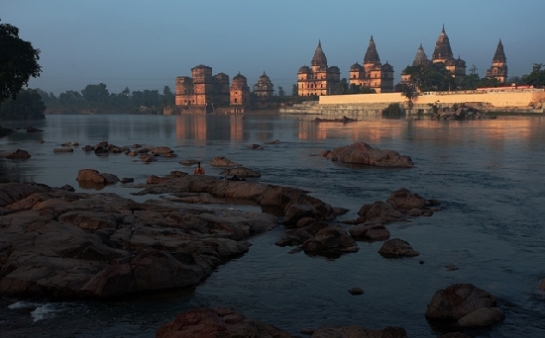Magnificent Cenotaphs of Orchha and their history
Orchha has 15 chhatris or memorials for its rulers, located near the Kanchan Ghat on River Betwa. The chhatris provide a beautiful view to tourists from the bridge on River Betwa, from where tourists can enjoy the look of the magnificent monuments and their reflection in the river.
Fifteen cenotaphs to the Bundela kings and members of their clan are located on the southern bank of river Betwa. These include the Chhatries of Madhukar shah, Vir Singh Deo, Jaswant Singh, Udait Singh, Pahar Singh & Others. Most of the cenotaphs are designed in Panchaytan style. They are constructed on an elevated square platform.
Cenotaph of Banka Umed Singh Ji
Banka Umed Singh was descendant of Haradaul and son of Rai Singh (a brother of Maharaja Udot Singh) this cenotaph was rectangular Mandap having three arched door. Sanctum has an image of Umed Singh wife his consort fixed on the back wall. An inscription of three lines carved on the canopy of image mentions 1742 A.D. The sanctum is topped with a small dome.
Cenotaph of Vir Singh Deo
The rule of Vir Singh deo (1605-1627 A.D) is regarded as the golden era in the annals of Bundela dynasty. He built the grand & Majestic building i.e Jahangir Mahal, Phoolbagh,Lakshminarayana Temple, Hamam and Naubatkhana. The cenotaph of Vir Singh Deowas build was Jujhad singh in 1627.1628 A.D. construction on an elevated square platform. The sanctum sanctorum too is square shaped and in structure is threestoreyed. The joining on each of the floor has balconies, most of which have not been able to survive and ravages of the time. The flow of the Betwa River touches the bottom of platform making it more scenic.
Cenotaph of Maharaja Indramani
King Sujan Singh was succeeded by his younger brother Indramani in 1672 who died in 1675 A.D. His son Jasawant Singh succeeded him. He constructed this cenotaph in 1675 A.D. This three cenotaph is built in square plan. Having square sanctum surrounded by rectangular chambers with three arched door and each corner has a square room connecting the verandah on both side. Sanctum has large Nagar style spire and at each corner square rooms topped with domes depicting the panchayatam style. The outer niches carred arched doors profusely of lotus designs in the decoration of cenotaph depicts the developed phase of Bundela architecture.
Cenotaph of Maharaja Bhagawant Singh
King Jasawant singh died in 1684 A.D and was succeeded by his minor son Bhagwant Singh. The Maharani Amar Kawari became the regent. After the death of Bhagwant Singh, The maharani adopted Udot Singh who belonged to Hardaul branch of the family in 1689 A.D. Udot Singh constructed this cenotaph in 1689 A.D. This cenotaph is square in plan. Having square sanctum with arched doorways on four side, a rectangular passage and corner square rooms connected with the passage on both side. The three cenotaphs have a large Nagar style spire at the Top and each corner, square room is topped with dome making it an example of the panchayatan style. The decoration of the doms,spire,niches and gates are in typical Bundela style.
Cenotaph of Jashwant Singh
King Indramani was succeeded by his son Jashwant Singh, as ruled at Orchha from 1675 A.D to 1684 A.D. Mughal Emperor Aurangzeb granted him Khillat in 1683 A.D. He died in 1684 and was succeeded by his minor son, Bhagwant singh. This cenotaph was constructed by his mother Amarkumwari in 1684. The Cenotaph has a square sanctum with arched doorways in each direction in Sarvathobhadra style and surrounded by rectangular passage having three arched doors towards the courtyard with each corner having square rooms connected to the passage on both side. The three storeyedstructure has a large spire of Nagar. Style in middle and each corner square rooms are surmounted with decorated dome. making it an example of the panchayatan style. The decoration of the shikhar inverted lotus at top of domes octagonal base and Kalashniches and archer door are again typical of the Bundeli architectural style.
Cenotaph of Maharaja Sujan Singh

King Sujan Singh succeeds his father Pahad Singh 1653 A.D and died in 1672 without any issue. His younger brother Indramani succeeded his started to construct this cenotaph but it was completed later by Jasawant Singh (1675-1684 A.D).It is the earliest cenotaph of this campus which show the developed stage of Bundela cenotaph architecture. It was a square plan, having square sanctum at Middle and surrounded by rectangular chambers with three arched doors towards the courtyard. Each corner has a square rooms connected with a rectangular chamber. Sanctum has a four arched doors in each direction leading onto the outer chambers. Three storeyed sanctum hasNagar style spire but each corner has dome above square rooms. The decoration of the cenotaph is typical of Bundela architecture.
Cenotaph of Bharti Chandra

The first Bundela king of Orchha, Bharti Chandra (1531-1554 A.D) died in 1554 A.D and was succeeded by his younger brother Madhukar Shah (1554-1592 A.D) who built in two stage domes were added in 17th Century A.D and beautiful painting were done. Under the Chhajja it has also inscriptions dated 1675 A.D to 1683 A.D below the Chajjabetween brackets. Cenotaph has square sanctum surrounded by rectangular passage having arched doors. At the top each corner has a square room topped with domes and a large dome at middle. This cenotaph is one of the examples of Bundela cenotaph architecture.
A holiday spent here is worth admiring!! Feel Free to contact
|
Amar Mahal
|
|
|
Orchha, District Tikamgarh,
|
|
|
Madhya Pradesh – INDIA
|
|
|
Tel : + 917680252102, 252202
|
|
|
Fax : +917680-252203
|
|
|
email : reservation@amarmahal.com
|
|






Gorgeous photographs and beautiful articulation… Cenotaphs at Orchha are incredible architecture… Serene….
Nice clicks…Superb
Pingback: Best of Orchha- the hidden town’s top tourist destinations | orchha